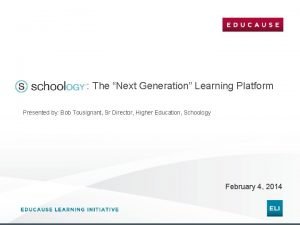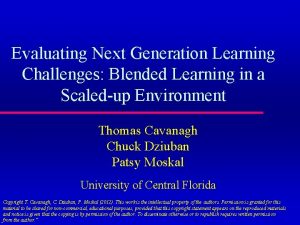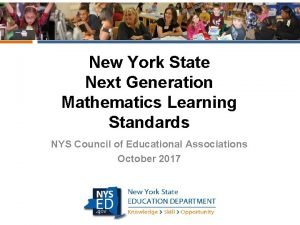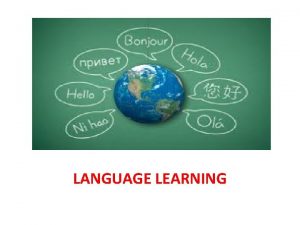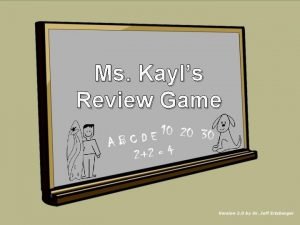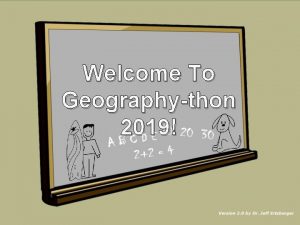Where next for language learning The effects of





















- Slides: 21

Where next for language learning? The effects of policy on university language learning

An overview of numbers 14/15* FT Undergraduate degree: 74, 760 ‘Other’ Undergraduate: 1, 895 FT Postgraduate degree: 10, 820 PT Undergraduate degree: 9, 880 PT Postgraduate degree: 4, 555 and ‘around 55, 000’ taking extracurricular languages courses of some sort. * Source: Higher Education Statistics Agency 2014

Policy context (1): the school curriculum 2004: There is some evidence of a modest increase in opportunities to study a language within the primary school curriculum, but secondary state school pupils can drop modern foreign language study at age 14. 2007: CILT Five Years On report suggests ‘a substantial decline’ in GCSE and A level entries. 2009: Worton report ‘ …. . (while) this decline appears to have levelled out, take-up post-14 remains low. ’ 2010: CILT survey confirms downward trend. 36% of state schools report 50% of pupils studying a language between the ages of 14 – 18.

The school curriculum (2) ‘Ireland the UK are the only countries where students at upper secondary education are not studying any foreign language (19% and 51% respectively). ’ Source: Eurostat 2010

However…. . two points to note There is a marked difference between England, Wales and Northern Ireland combined and Scotland ‘…. . the assumption of a ‘common fate’ for MFL [Modern Foreign Languages] may need to be reconsidered. ’ (UCML)

Policy context (2): strategic HEFCE 2008: ‘ Languages and area studies are deemed strategically important and vulnerable [and we should] consider the interventions necessary to address this. ’ Eurostat survey 2010: correlation between a high level of education and proficiency in foreign languages. 75% of mainland Europeans in upper secondary education are studying 2. Global Trends in Language Learning in the 21 st Century: ‘Learning a second language is…one of a number of skills which may help an individual acquire meaningful employment. ’

And beyond Europe…… ‘Mastery of a second language allows you to capture the nuances that are essential to true understanding. This is not about learning something that is helpful or simply nice to have. It is crucial to our mission. ’ Leon Panetta, 2010 CIA Director, 2009 – 2011; US Defense Secretary, 2011 - 2013

UK policy context (2): post-16 Who pays? Major shift from public to individual funding, offset by bursaries, loans, future graduate employment expectations. Who participates? Arrangements to encourage/make universities cater for different kinds of full-time and part-time students, for example: 2008 ruling on Equivalent or Lower Qualifications (ELQS) HE premium for attracting under-represented socio-economic groups (and penalties for not!) Access (or not) to bursaries/loans Higher fees for international students

UK policy context post -16 (contd. ) Who provides? Higher Education Institutions, University Colleges, Further Education Colleges. Private providers. See particularly the May 2016 Government White Paper Higher education: success as a knowledge economy. informal provision eg community schools Curriculum General purposes, vocational, professional orientations

Attitudes to language capability British Council survey, 2015 (2, 000 adults) 65% thought it important to learn a few words or phrases. 48% enjoyed trying out their language on holiday. 40% are ‘embarrassed’ by their language skills. 36% assumed everyone would speak English. 25% felt nervous at the thought of having to speak another language on holiday. 19% would select a destination where they knew they wouldn’t have to! 16% could speak a foreign language to a high level.

Implications Social, political and cultural contexts have a significant effect on the extent to which capability in a language is seen as an integral part of any education promoted as a skill in its own right identified as economically or strategically meaningful As University MFL departments contract or close, institution-wide language provision (IWLP) plays a significant role in language learning.

UCML/AULC survey; methodology Responses from heads of University Language Centres and heads of University Modern Languages departments. Conducted October 2015, published March 2016. Respondents: 61 universities.

Key findings Diverse models and range of languages Mean: 9; range: 3 - 20 ‘…. a general pattern of increasing enrolments…. IWLP is an expanding area, attracting increasing numbers of students. ’ 2012/13: 49, 637 2015/16: 55, 354 ‘over 60, 000’ if Spring enrolments are included. (HESA’s ‘around 55, 000’? )

Which languages? Greatest demand for Spanish, then French. Next most popular: German, Japanese, Chinese. Steady decline in demand for Italian. 57% of respondents thought the future for IWLP in their institution was ‘encouraging’ but 38% thought it ‘uncertain. ’ Universities trying to cut costs? Since the survey, possible implications of Brexit?

Who and at which levels? Who? AULC survey noted the difficulty of asking IWLP managers to identify specific groups by eg gender, age, previous language learning experience. Onerous and not necessarily informative. Likely to vary across institutions. Which level? For the vast majority of institutions, the levels are aligned to the Common European Frame of Reference. Overall, a general tendency for numbers to diminish at higher levels, except for specialist/professional provision.

Motivation? Instrumental motivation Integrative motivation employability love of learning mobility personal fulfilment career progression sense of satisfaction formal or informal links with country/countries curiosity

Curriculum design and delivery face to face, blended, distance long-thin, short-fat courses integrated or discrete skills development customised for specific purposes building capabilities, gaining credits, both? AULC/UCML: ‘Broad support’ for UNILANG initiative, a national scheme to recognise and certify students’ learning. Pilot scheme launched, Autumn 2016.

An overview of numbers 14/15* FT Undergraduate degree: 74, 760 ‘Other’ Undergraduate: 1, 895 FT Postgraduate degree: 10, 820 PT Undergraduate degree: 9, 880 PT Postgraduate degree: 4, 555 and ‘around 55, 000’ taking extracurricular languages courses of some sort. * Source: Higher Education Statistics Agency 2014

What happened next? * Employment or further study (UK or overseas), combination of work and further study: 88%. Unemployed: 6%. Not known: 6% Consistent with most other degree subjects, but numbers of languages graduates are smaller. Medicine and allied subjects: 40, 105 graduates Business studies: 35, 620 graduates Languages: 19, 950 graduates * Source: HESA, Graduate First Destinations Survey

Implications for teaching nonspecialist language learners? Greater variety of motivations and perceptions prior knowledge prior experience as a learner Time pressures: language learning is fitting round other things eg work, family life. Familiarity with eg using technology. Possible curriculum limitations compared to degree study.

References Higher Education Statistics Agency HESA Worton, M (2009) Review of Modern Foreign Languages provision in Higher Education in England. HEFCE. Worton Report Mejey L, Boateng SK, Turchetti P (2010) Linguistic diversity in Europe Eurostat paper 49/2010 EUROSTAT 49/2010 Eaton SE (2010) Global Trends in Language Learning in the Century. Calgary: Onate Press Global Trends CIA News (December 8 th 2010) Panetta CIA UK Government (May 2016) Higher Education: success as a knowledge economy. White Paper. Department for Business, Innovation and Skills Canning J (2007) Five Years On. The Higher Education Academy, Languages, Linguistics and Area Studies Subject Centre Campbell C, Cirillo C, Critchley M & Morley JUCML/AULC survey of Institution-Wide Language Provision in universities in the UK (2015 -16) UCML/AULC survey Tinsley T, Board K (2013) Languages for the future. British Council. Sellgren K (August 2015) Britons ‘nervous to speak foreign language when abroad’ BBC Education news, accessed 27/09/16
 X.next = x.next.next
X.next = x.next.next Cuadro comparativo e-learning y b-learning
Cuadro comparativo e-learning y b-learning -54
-54 Scienze della formazione
Scienze della formazione Next generation lms
Next generation lms Next generation learning challenges
Next generation learning challenges Nys next generation standards math
Nys next generation standards math Fspos vägledning för kontinuitetshantering
Fspos vägledning för kontinuitetshantering Typiska novell drag
Typiska novell drag Tack för att ni lyssnade bild
Tack för att ni lyssnade bild Returpilarna
Returpilarna Shingelfrisyren
Shingelfrisyren En lathund för arbete med kontinuitetshantering
En lathund för arbete med kontinuitetshantering Personalliggare bygg undantag
Personalliggare bygg undantag Personlig tidbok fylla i
Personlig tidbok fylla i Sura för anatom
Sura för anatom Förklara densitet för barn
Förklara densitet för barn Datorkunskap för nybörjare
Datorkunskap för nybörjare Boverket ka
Boverket ka Debatt artikel mall
Debatt artikel mall Delegerande ledarskap
Delegerande ledarskap Nyckelkompetenser för livslångt lärande
Nyckelkompetenser för livslångt lärande




